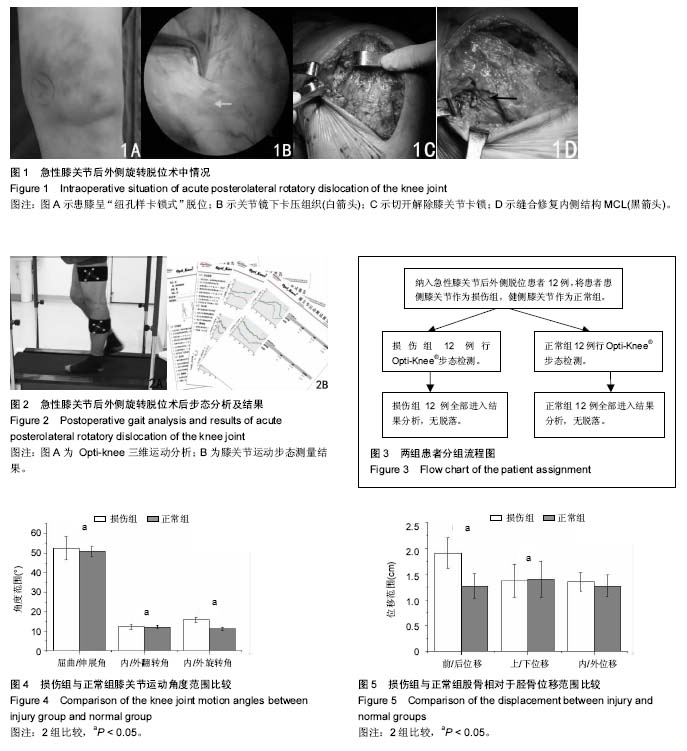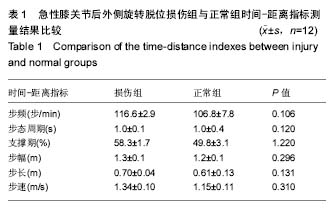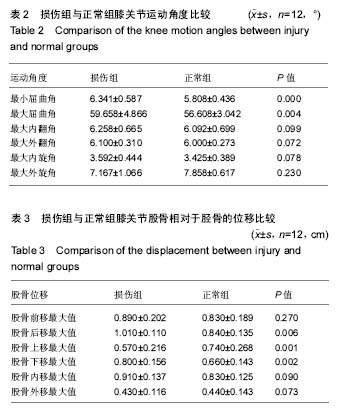| [1] Arom GA, Yeranosian MG, Petrigliano FA, et al. The changing demographics of knee dislocation: a retrospective database review. Clin Orthop Relat Res. 2014;472(9):2609-2614.[2] Benoit DL, Ramsey DK, Lamontagne M, et al. Effect of skin movement artifact on knee kinematics during gait and cutting motions measured in vivo. Gait Posture. 2006;24(2):152-164.[3] Schenck RC Jr, Richter DL, Wascher DC. Knee Dislocations:Lessons Learned From 20-Year Follow-up. Orthop J Sports Med. 2014;2(5): 232596711453487.[4] 何锐,杨柳,郭林,等. 急诊关节镜下清创复位联合二期韧带重建治疗急性膝关节后外侧旋转脱位[J]. 中国骨科临床与基础研究杂志, 2012, 4(2): 102-109.[5] Wascher DC. High-velocity knee dislocation with vascular injury.Treatment principles. Clin Sports Med. 2000;19(3): 457-477.[6] Howells NR, Brunton LR, Robinson J, et al. Acute knee dislocation: an evidence based approach to the management of the multiligament injured knee. Injury. 2011;42(11): 1198-1204.[7] Fanelli GC. Multiple ligament-injured (dislocated) knee. Sports Med Arthrosc. 2011;19(2): 81.[8] Capito N, Gregory MH, Volgas D, et al. Evaluation and management of an irreducible posterolateral knee dislocation. J Knee Surg. 2013;26(1): S136-S141.[9] Smyth MP , Koh JL. A review of surgical and nonsurgical outcomes of medial knee injuries. Sports Med Arthrosc. 2015; 23(2): e15-22.[10] Werner BC. Medial injury in knee dislocations: what are the common injury patterns and surgical outcomes? Clin Orthop Relat Res. 2014;472(9): 2658-2666. [11] 孙正宇,张承昊,唐新,等. 一期修复重建膝关节脱位多发韧带损伤的疗效观察[J]. 中国修复重建外科杂志, 2016, 30(6): 690-694.[12] 陈刚,付维力,唐新,等. 关节镜辅助治疗陈旧性膝关节后外侧旋转脱位[J]. 华西医学, 2016, 31(6): 1057-1061.[13] 张承昊, 李棋, 李箭. 华西膝关节脱位多发韧带损伤分期分型诊断及对治疗的指导意义的初步研究[A].中华医学会第十七届骨科学术会议暨第十届COA国际学术大会.重庆, 2015.[14] Howells NR, Brunton LR, Robinson J, et al. Acute knee dislocation: an evidence based approach to the management of the multiligament injured knee. Injury. 2011;42(11): 1198-1204.[15] Tibor LM. Management of medial-sided knee injuries. Part2: Posteromedial corner. Am J Sports Med. 2011;39(6): 1332-1340.[16] Levy BA, Dajani KA, Whelan DB, et al. Decision making in the multiligament-injured knee: an evidence-based systematic review. Arthroscopy. 2009;25(4): 430-438.[17] 皇甫小桥,赵金忠,何耀华,等. 膝关节多发韧带损伤的修复与重建[J]. 中华骨科杂志, 2011, 31(2): 164-168.[18] Khakha RS, Day AC, Gibbs J, et al. Acute surgical management of traumatic knee dislocations - Average follow-up of 10years. Knee, 2015.[19] McKee L, Ibrahim MS, Lawrence T, et al. Current concepts in acute knee dislocation: the missed diagnosis? Open Orthop J. 2014;27(8): 162-167.[20] Polyzois VD, Stathopoulos IP, Benetos IS, et al. A Two-stage procedure for the treatment of a neglected posterolateral knee dislocation: Gradual reduction with an Ilizarov external fixator followed by arthroscopic anterior and posterior cruciate ligament reconstruction. Knee. 2016;23(1): 181-184.[21] Kohl S, Stock A, Ahmad SS, et al. Dynamic intraligamentary stabilization and primary repair: a new concept for the treatment of knee dislocation. Injury. 2015;46(4): 724-728.[22] Said HG, Learmonth DJ. Chronic irreducible posterolateral knee dislocation: two-stage surgical approach. Arthroscopy. 2007;23(5): e561-564.[23] Laprade RF, Wijdicks CA. The management of injuries to the medial side of the knee. J Orthop Sports Phys Ther. 2012; 42(3):221-233.[24] Fanelli GC, Edson CJ. Surgical treatment of combined PCL/ACL medial and lateral side injuries (global laxity): surgical technique and 2- to 18-year results. J Knee Surg. 2012;25: 307-316.[25] Georgoulis AD. Three-dimensional tibiofemoral kinematics ofthe anterior cruciate ligament-deficient and reconstructed knee during walking. Am J Sports Med. 2003;31(1): 75-79.[26] Hall M, Stevermer CA, Gillette JC. Gait analysis post anteriorcruciate ligament reconstruction: knee osteoarthritis perspective. Gait Posture. 2012;36(1): 56-60.[27] Takeda K, Hasegawa T, Kiriyama Y, et al. Kinematic motion of the anterior cruciate ligament deficient knee during functionally high and low demanding tasks. J Biomech. 2014;47(10): 2526-2530.[28] Polyzois VD, Stathopoulos IP, Benetos IS, et al. A Two-stage procedure for the treatment of a neglected posterolateral knee dislocation: Gradual reduction with an Ilizarov external fixator followed by arthroscopic anterior and posterior cruciate ligament reconstruction. Knee. 2016;23(1): 181-184.[29] 周敬滨,李国平,李方祥. 慢性膝关节前交叉韧带损伤患者步态的运动学分析[J]. 中国运动医学杂志, 2012, 31(10): 898-901, 912.[30] Brevetti C, De Caterina M, Martone VD, et al. Exercise increases soluble adhesion molecules ICAM-1 and VCAM-1 in patients with intermittent claudication. Clin Hemorheol Micorcirc. 2001;24(3): 193-199.[31] Wexler G, Hurwitz DE , Bush-Joseph CA, et al .Functional gait adaptations in patients with anterior cruciate ligament deficiency over time. Clin Orthop Relat Res. 1998;348 : 166-175.[32] 林泽枫,张余,马立敏,等. 外侧盘状半月板损伤患者膝关节在体运动学参数研究[J]. 中国骨科临床与基础研究杂志, 2014, 10(6): 291-296.[33] Barcellona MG, Morrissey MC, Milligan P, et al. The effect of thigh muscle activity on anterior knee laxity in the uninjured and anterior cruciate ligament-injured knee. Knee Surg Sports Traumatol Arthrosc. 2014;22(11): 2821-2829. [34] Griffith CJ, Wijdicks CA, LaPrade RF, et al. Force measurements on the posterior oblique ligament and superficial medial collateral ligament proximal and distal divisions to applied loads. Am J Sports Med. 2009;37: 140-148.[35] Leiter JR, Gourlay R, McRae S, et al. Long-term followup of ACL reconstruction with hamstring autograft. Knee Surg Sports Traumatol Arthrosc. 2014;22(5):1061-1069.[36] Lafortune MA, Cavanagh PR,Sommer HJ 3rd, et al. Three dimensional kinematics of the human knee during walking. J Biomech. 1992;25(4):347-357.[37] Snyder -Mackler L, Ladin Z, Schepsis AA, et al.Electrical stimulation of the thigh muscles after reconstruction of the anterior cruciate ligament .Effects of electrically elicited contraction of the quadriceps femoris and hamstring muscles on gaitand on strength of the thigh muscles. J Bone Joint Surg Am. 1991;73(7):1025-1036.[38] Timoney JM, Inman WS , Quesada PM, et al. Return of normal gait patterns after anterior cruciate ligament reconstruction.Am J Sports Med. 1993;21(6):887-889.[39] Houston ME, Goemans PH. Leg muscle performance of atheletes with and without brace. Arch Phys Med Rehabil. 1982;63 :431-436.[40] Branch T, Hunter R, Donath M. Dynamic EMG analysis of anterior cruciate deficient legs with and without bracing during cutting. Am J Sports Med. 1989;17:35-39.[41] Gao B, Cordova ML, Zheng NN. Three-dimensional joint kinematics of ACL-deficient and ACL-reconstructed knees during stair ascent and descent. Hum Mov Sci. 2012;31(1): 222-235. |
.jpg)



.jpg)